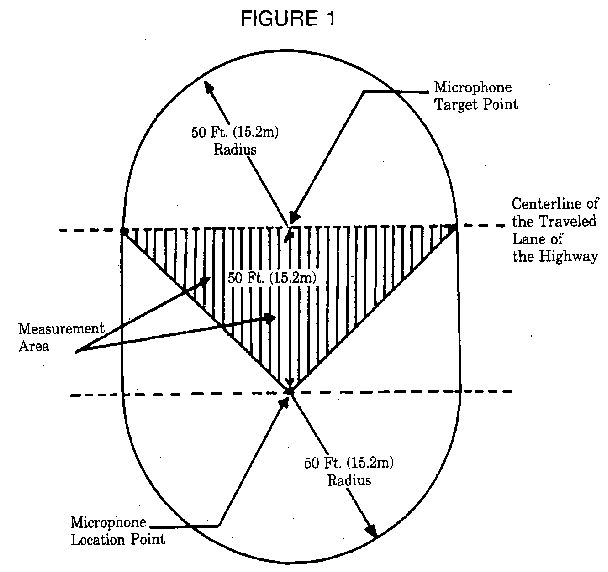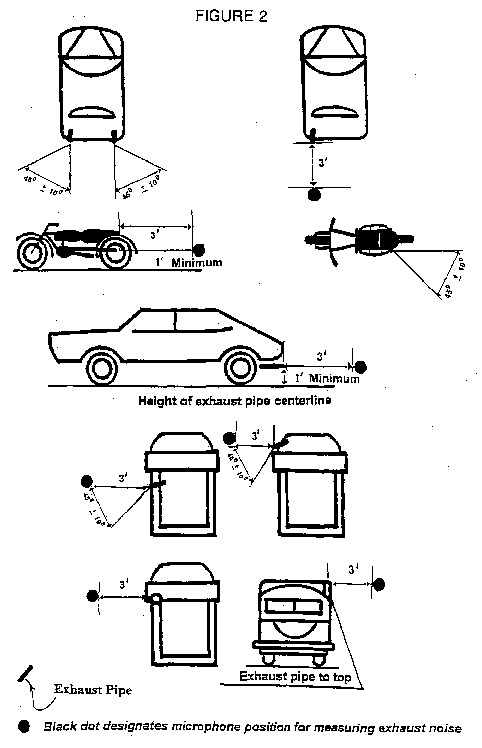 |
Code of Maryland Regulations (Last Updated: April 6, 2021) |
 |
Title 11. Department of Transportation |
 |
Subtitle 14. MOTOR VEHICLE ADMINISTRATION—VEHICLE INSPECTIONS |
 |
Chapter 11.14.07. Noise Abatement Program |
Sec. 11.14.07.05. Standard Measurement Site for Highway Operation of all Vehicles over 10,000 Pounds GVWR and GCWR
-
A. Moving Vehicle Measurement Procedures.
(1) Measurement shall be made at a measurement site which is adjacent to, and includes, a portion of a traveled lane of a public highway. A microphone target point shall be established on the centerline of the traveled lane of the highway and a microphone location point shall be established on the ground surface 50 feet (15.2m) from the microphone target point. Within the site is a triangular measurement area. A plan view diagram of a standard site, having an open site within a 50 foot radius (15.2m) of both the microphone target point and the microphone location point, is shown in Figure 1.
(2) The sound level generated by the motor vehicle is the highest reading observed on the sound level measurement system as the vehicle passes through the measurement site. The sound level of the vehicle being measured shall be observed to rise at least 6 dB(A) before the maximum sound level occurs and to fall at least 6 dB(A) after the maximum sound level occurs.
(3) Standard Measurement Site Highway Operations.
Figure 1.

B. Stationary Vehicle Measurement Procedures for Vehicles Over 10,000 Pounds GVWR and GCWR.
(1) The motor vehicle to be tested shall be parked on a flat open area free of acoustically reflective surfaces (except those of the vehicle under test) that are within 15 feet of the microphone measuring position. See Figure 2 for microphone orientation. Before starting the sound level measurement, the vehicle engine should be at normal operating temperature.
(2) The microphone shall be located at a height equal to that of the exhaust discharge opening (but not less than 1 foot from the ground) and shall be positioned 3 feet from the exhaust opening with the microphone in a vertical or a grazing position and as far as possible from any acoustically reflective surfaces associated with the vehicle being tested, the inspecting officer, or the associated testing equipment. See Figure 2.
(3) All auxiliary equipment such as cranes, asphalt spreaders, liquid or slurry pumps, auxiliary air compressors, welders or trash compactors, which are installed on the motor vehicle and which are designed to operate under normal conditions when the vehicle is operating at a speed of 5 miles per hour (8 kph) or less, shall be turned off.
(4) If the motor vehicle engine radiator fan drive is equipped with a clutch or similar device that automatically reduces the rotational speed of the fan or completely disengages the fan from its power source in response to reduced engine cooling loads, park the vehicle before testing with the engine running at high idle or any other speed the operator may choose, for sufficient time but not more than 10 minutes, to permit the radiator fan to automatically disengage.
(5) Stationary measurements require that the microphone be located 3 feet from the vehicle exhaust opening, as shown in Figure 2. There shall be no acoustically reflective objects closer than 15 feet to the microphone measuring position except those of the vehicle under test, the inspecting officer, and the associated testing equipment.
(6) Standard Measurement Site Stationary Operations.
Figure 2.

(7) A motor vehicle with a manual transmission shall be in neutral and the clutch engaged. A motor vehicle with an automatic transmissions shall be in park or in neutral.
(8) With the compression brake engaged (if the vehicle is so equipped) and the engine at idle, the sound level measurement shall be started. Then, the throttle shall be rapidly depressed to wide open and returned to idle speed. This procedure is repeated for a total of 3 engine run-ups during the measurement period. For vehicles without an engine speed governor, the engine shall be accelerated to approximately one-half throttle.
(9) If the motor vehicle is equipped with dual exhausts, these procedures shall be applied to both sides of the motor vehicle.
(10) If all 3 engine run-up maximum sound level measurements exceed the maximum permitted level specified in Table 3 for the category of the vehicle under test, a noise violation exists. This test procedure may be repeated if deemed necessary by the inspecting officer.